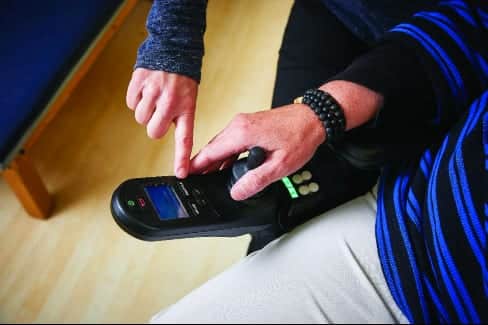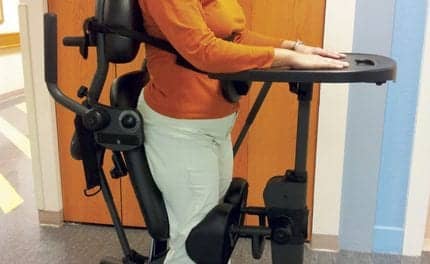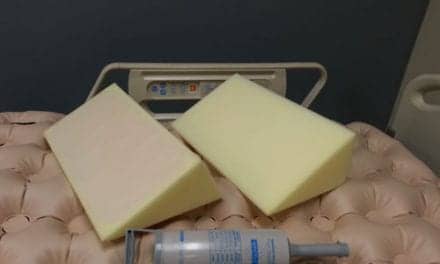photo caption: Depending on the patient’s individual needs, full-power chairs offer more options, including power-seat functions that help with weight shifting, skin preservation, and postural support.
by Amy Kirkner, MPT
Patients who rely on a wheelchair for mobility may one day need to transition from a manual to power-assist or full-power option in order to maximize their safety and independence, and improve function, comfort and quality of life.
The transition to a power wheelchair can be complex for patients, as well as for family members and caregivers. However, patients can benefit from the expertise of a wheelchair clinic in a number of ways, including exposure to clinical knowledge of transition eligibility, devices that insurances will cover, and the ability to educate and support patients, family members, and caregivers for a successful and safe transition.
Potential for Power Transition Begins with Patient Goals and Medical Evaluation
At Good Shepherd Rehabilitation Network’s Wheelchair Clinic, Allentown, Pa, patients seeking a wheelchair evaluation require a doctor’s prescription. Upon arrival, patients undergo a full intake and evaluation for clinicians to understand patients’ individual goals and concerns, and to determine medical justification for the specific equipment.
Wheelchair clinic patients typically present with one of a number of conditions, including spinal cord injury, cerebral palsy, ALS, spina bifida, multiple sclerosis, brain injury, and muscular dystrophy. When establishing medical justification, clinicians evaluate physical measurements, range of motion and more, including:
• Strength
• Coordination
• Sensation
• Reflexes
• Skin integrity
• Balance
• Transfers
• Ambulation
• Fall risk
It is also important to consider how a transition to power-assist or full-power can help the patient medically as well as whether there is upper-extremity pain in shoulders, elbows, or wrists. Additional considerations include whether there is upper-extremity weakness or positioning issues (ie, posture and comfort) present, and if skin integrity is compromised. Depending on age and condition, patients can face endurance issues or compromise, resulting in decreased function and decreased distance mobility.
Examining Home and Transportation
When considering transitioning a patient from a manual to power wheelchair, it is critical to ensure that the person has access to transportation and home accessibility. For transportation, does the patient have access to public transportation or their own vehicle to accommodate the mobility equipment? In regard to home accessibility, some insurance companies will not approve reimbursement if certain criteria are not met. Among those criteria are considerations about whether the home’s entrance is flat or whether there is ramping to travel in and out of the home. For example, if a patient is a renter and the landlord has not provided ramping, the request could be denied by insurance, no matter how strong the medical necessity for the patient.
Additionally, work and school environments also require consideration: Are there sufficient door, hallway, and room dimensions, and what distances do patients have to travel? Is the patient able to complete work/school responsibilities, and can that person keep up with his or her peers?
Identifying Other Trouble Spots
In a manual-to-power transition, clinicians also examine the family/caregiver dynamic. Are patients and family members or caregivers in agreement with needs and goals? Or, is there disagreement among involved parties on transitioning from manual to power? In some instances, patients are not ready psychologically to give up the activity of propulsion from their daily lives. In other cases, family members/caregivers view a transition to a power chair as a step back in independence when patients feel otherwise. These interpersonal relationships offer valuable insight when evaluating the manual-to-power transition. The patient’s full care team needs to be on the same page to make this transition successful.
Why Transition Directly to Full-Power
When assessing a patient’s potential transition from manual wheelchair to power-assist or full-power wheelchair, there are a number of considerations. A significant concern is funding accessibility. Several insurances will not recognize or approve power-assist but will consider full-power. The variability in reimbursement places patients in a challenging position to make decisions alongside their clinician and family members/caregivers, particularly when private pay is not an option due to financial constraints.
Patients who are diagnosed with progressive illnesses such as muscular dystrophy or multiple sclerosis and start in a manual wheelchair may benefit from transitioning directly to full-power instead of power-assist. In this scenario, power-assist often is not adequate for providing the patient with independence to self-propel, reposition, and weight shift. Rather, full-power wheelchairs are best for the patient.
Additionally, depending on the patient’s individual needs, full-power chairs offer more options, including power-seat functions that help with weight shifting, skin preservation, and postural support, as well as progressing to alternate drive controls as needed.

Why Transition to Power-Assist
A patient may prefer to transition to a power-assist wheelchair rather than full-power for a number of reasons. Some patients have the option and ability to break apart the chair and put it in a vehicle for transport. Other patients choose power-assist because they do not want power at all times; they prefer to use manual in their home and power in environments outside the home where there may be inclines or they have to travel long distances (ie, across a school or work campus or within medical facilities for appointments). An unwillingness to give up manual propulsion as part of their daily activity also can be a factor, as sometimes patients feel as though manual propulsion is part of their daily exercise and they are reluctant to relinquish it.
When Starting with the Manual Option Is Not Appropriate
For some patients, a manual wheelchair is not an appropriate choice from the very beginning. These are instances when patients lack the strength to propel themselves. Or, they need more postural support than a manual chair can provide (ie, power tilt, recline). Other patients present with pulmonary issues, which limit breathing and the physical ability to propel. Patients with endurance issues from conditions such as cancer, multiple sclerosis, or ALS also may need to move directly to power because they lack the ability to propel a manual wheelchair.
Setting Patients Up for Success
Each patient has different needs, which is why it is important to have baseline protocols in place for evaluating appropriate wheelchair options.
Patients can trial a variety of wheelchairs, mobility systems, and seating options. At Good Shepherd’s clinic, for example, clinicians provide instruction and training on the use of manual and motor wheelchairs. Following the wheelchair evaluation, the wheelchair clinic provides results of the medical evaluation to patients’ physicians and selected durable medical equipment vendors. The team works to coordinate equipment delivery, adjustment, and training for patients, making it all the more likely for a successful transition. RM
Amy Kirkner, MPT, is a staff therapist and wheelchair clinic coordinator at Good Shepherd Rehabilitation Network’s Wheelchair Clinic in Allentown, Pa. For more information, contact [email protected].





